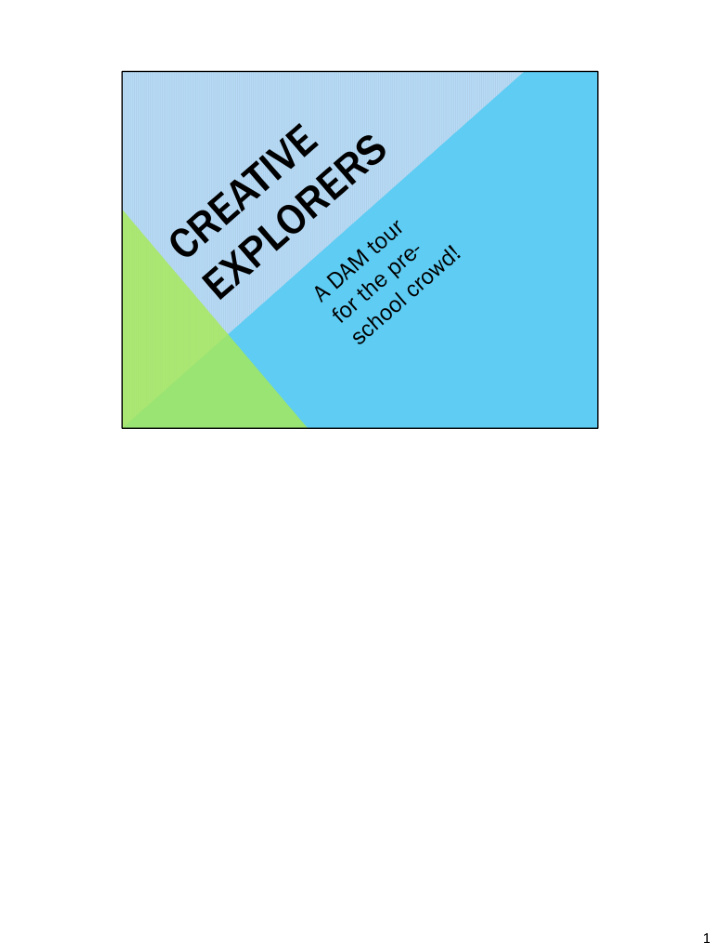



1
History: 2009, Informal observation resulted in ‘Create Playdate” a drop in program for the stroller crowd. Consisting of a gallery experience with a story and a related art making project. Education, under the direction of experts, conducted focus groups of parents and grandparents to determine appropriate use of museum resources. Result = more evidence that this was an underserved population. 2
Staff and docent task force formed. This group laid out a plan to move forward. 3
October of 2014 – staff and docents participated in a multiday summit on early childhood conducted by SEEC (Smithsonian Early Childhood Center). Pre-school teachers and child care providers were invited to participate in panel discussions about successful curricula for the young child. We then engaged the advice of Denver Public Library early childhood specialist. The latter fleshed out the science of learning and how we could use that information to create the best tour for the 3-5 year old visitor. 4
We reviewed a number of scholarly papers about learning and the young child. (IMLS mission …to inspire libraries and museums to advance innovation life long learning and cultural and civic engagement. Provide leadership through research, policy development and grant making.) 5
MEM (Mary Ellen Munley)= a consulting group dedicated to enhancing the role of museums in the lives of people. 6
Looking at the different parts of the brain that have to work almost simultaneously when processing language, children need us to be patient and give them time to respond. 7
Each time a child hears smells tastes touches or is touched the paths get built and get stronger. Strength increases if experiences are shared with others that are loving and positive. 90% of the brain’s learning pathways are developed between birth and four years old. It’s never to late to learn but it gets harder as we age. To debunk the notion that babies are born with a “blank slate”, section one on the slide shows the brain pathways of a newborn. Section two is the brain of a 6 year old with tons of connections. The third shows the brain of a teenager that has undergone a process called neuro-pruning. Connections that are no longer needed are removed from the brain so that the brain works more effeciently. 8
Fun is a crucial component of success! 9
After exhaustive research and numerous conversations we drew up a statement of what we, at the DAM believe and that our tour for the pre-school crowd needed to reflect these beliefs. 10
The tour needed to foster each of these goals – in order to accommodate a large number of children and docents flexibility of location was a must! 11
Once tour components were in place training of docents was conducted by members of the task force and staff. The initial training consisted of four 2 hour sessions. 12
The tour is one hour long. Student/docent ratio ideal is1-5, travel games are played while moving from place to place (see manual for ideas). The first order of business is an introduction to the museum and museum manners(many have never been to the museum/many are non-English speaking). Because play is universal and necessary for comfort, all activities are rooted in FUN. 13
Mystery and surprise build anticipation…. Very important to remember that not all learners look the same… often children look like they are not participating but when engaged in art making/story/postcard show that they were totally with us. 14
From teachers we learned that this age group is more comfortable knowing what is going to happen. We use a visual agenda to show what is going to happen and as a task is complete it is recorded. 15
Explore and Sort – time is spent exploring together how artists use a variety of colors, materials and shapes in the art. Children discuss what they are seeing (often quite hysterical exchange – embrace it). A box of materials is then shown to the children and they select objects that they associate with the art object. Once that is complete the choices are sorted by size/shape/color. If time, a sculpture is built by the children using their materials. You know you are successful if students are looking closely and making connections between materials and the art object. 16
An object is chosen to support the selected story, story is read and connected to the art object. You know you are successful if: Students enjoy the story, making predictions, observations and connections. In addition, students see how the artwork connects to the story and how creative thinking applies to them. 17
There are other choices of stories. Each encourages creative thinking and imagination. 18
Students make their own selection of materials and create an object unique to them. You know you are successful if: Students make their own choices and think creatively about how they can use materials. In addition students create werable art inspired by what they have seen. 19
Students are given a collection of materials to chose from that remind them of their visit. The materials are glued to a post card that can be taken with them. They are encouraged to use the postcard to share their memory with others. 20
Each of the activities address the goals. 21
That is a lot of three and four year olds visiting the DAM. 22
Recommend
More recommend